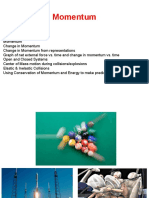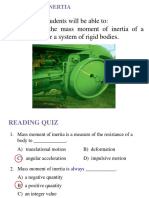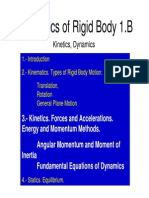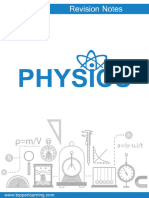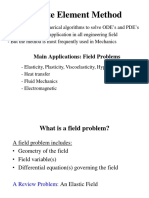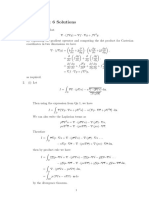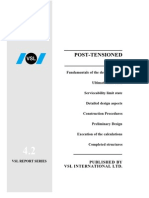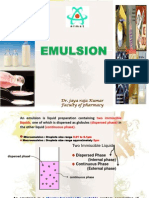0 ratings0% found this document useful (0 votes)
112 viewsLink Segment Model Winter
This document discusses Newton's laws of motion and how they relate to analyzing human movement using a link segment model. The link segment model treats the body as a series of rigid segments connected by joints. It requires information about each segment's mass, moment of inertia, position data over time, and any external forces. Using inverse dynamics calculations based on Newton's laws, the model can determine the joint forces and torques required to produce the observed motion.
Uploaded by
Hossein NajjarzadeCopyright
© © All Rights Reserved
Available Formats
Download as PPT, PDF, TXT or read online on Scribd
0 ratings0% found this document useful (0 votes)
112 viewsLink Segment Model Winter
This document discusses Newton's laws of motion and how they relate to analyzing human movement using a link segment model. The link segment model treats the body as a series of rigid segments connected by joints. It requires information about each segment's mass, moment of inertia, position data over time, and any external forces. Using inverse dynamics calculations based on Newton's laws, the model can determine the joint forces and torques required to produce the observed motion.
Uploaded by
Hossein NajjarzadeCopyright
© © All Rights Reserved
Available Formats
Download as PPT, PDF, TXT or read online on Scribd
You are on page 1/ 10
Link Segment Model
Joint Reaction Forces
Muscle Moments
Joint Power
Newtons Laws of Motion
I. Law of Inertia: A body at rest stays at rest and a
body in motion stays in motion unless acted upon
by a force or torque.
II. Law of Acceleration: The acceleration a body
experiences is directly proportional to the force or
torque, inversely proportional to the mass or
moment of inertia and occurs in the direction of the
force or torque.
III. Law of Reaction: For every action there is an
opposite reaction.
Newtons First Law: Law of Inertia
Law of Inertia: A body at rest stays at rest and a body in
motion stays in motion unless acted upon by a force or
torque.
Mass is the measure of an objects resistance to linear
change.
Moment of inertia is the measure of an objects resistance
to angular change.
F = m a T = I
To solve for forces and torques, we need both mass
and moment of inertia.
Moment of Inertia (I)
ICG= 3.5 kgm2
I CG md 2
The Moment of Inertia (I) represents
ICG= 15 kgm
2
an objects resistance to angular change
ICG= 6.5 kgm 2
about some axis.
Moment of inertia is a sum of the
product of mass times the squared
distance of the mass about the axis.
ICG= 83 kgm2 When body parts are moved closer to
the axis of rotation the moment of
inertia (resistance to spin) is reduced.
Link Segment Model Assumptions
Each segment has a fixed mass located at its center of mass
The joints are considered as hinge joints
The moment of inertia is fixed during movement
The length of each segment is constant
Input Information to Mass & moment of inertia of
Solve for Joint Forces each segment.
and Torques
Location of each segments
Center of Mass (CM).
Position, velocity, acceleration of
each segments CM (x, y, Vx, Vy,
Ax, Ay).
Angular position, velocity,
acceleration about each segments
CM (, , ).
External forces for all contact
points.
Center of pressure or location of
Center of Pressure external forces acting on the
gives the location of body.
external forces acting
on the body.
Inverse Dynamics: Finding Forces & Torques from Position Data.
[working backward to solve for forces & torques]
Anatomical Relationship
Forces & Torques Acting On Each Segment
Joint Moments
You might also like
- Planar Kinetics of A Rigid Body: Force and AccelerationNo ratings yetPlanar Kinetics of A Rigid Body: Force and Acceleration25 pages
- System of Particles and Rotational MotionNo ratings yetSystem of Particles and Rotational Motion12 pages
- Rotation of A Rigid Body About A Fixed AxisNo ratings yetRotation of A Rigid Body About A Fixed Axis14 pages
- PHY 001 (Physics I) : Instructor: Dr. Mohamed Fouad SalemNo ratings yetPHY 001 (Physics I) : Instructor: Dr. Mohamed Fouad Salem26 pages
- 4310_Topper_21_101_3_4_126_System_of_Particles_and_Rotational_Motion_up201611021150_1478067617_5119No ratings yet4310_Topper_21_101_3_4_126_System_of_Particles_and_Rotational_Motion_up201611021150_1478067617_511921 pages
- 67778f8e4fa70922ac08710c_##_SYSTEM OF PARTICLES AND ROTATIONAL MOTIONNo ratings yet67778f8e4fa70922ac08710c_##_SYSTEM OF PARTICLES AND ROTATIONAL MOTION14 pages
- Rotational Equilibrium and Rotational DynamicsNo ratings yetRotational Equilibrium and Rotational Dynamics8 pages
- Class 11 Physics Notes Chapter 5 Studyguide360No ratings yetClass 11 Physics Notes Chapter 5 Studyguide36029 pages
- Rigid Body Dynamics (Apni Kaksha) (Z-Library)No ratings yetRigid Body Dynamics (Apni Kaksha) (Z-Library)65 pages
- Applications in Linear and Angular KineticsNo ratings yetApplications in Linear and Angular Kinetics30 pages
- Chapter 12 - Kinematics of a Particle (Edisi 12) Sd Rectangular ComponentsNo ratings yetChapter 12 - Kinematics of a Particle (Edisi 12) Sd Rectangular Components93 pages
- May-06 - 2024 Mon CH (17-1) Kinetics of Rigid Bodies MOINo ratings yetMay-06 - 2024 Mon CH (17-1) Kinetics of Rigid Bodies MOI19 pages
- PNEC Chapter 12 Kinematics of a Particle - Part-INo ratings yetPNEC Chapter 12 Kinematics of a Particle - Part-I93 pages
- Lecture 3 - Dynamics of Rotational Motion Torque Work On Rotating BodiesNo ratings yetLecture 3 - Dynamics of Rotational Motion Torque Work On Rotating Bodies17 pages
- Intact Stability: Session 1 Forces and Moments Centroids Gravitational StabilityNo ratings yetIntact Stability: Session 1 Forces and Moments Centroids Gravitational Stability56 pages
- Rotation_241204_232216-2c2055c3-b051-4be8-9aa6-25653a787983No ratings yetRotation_241204_232216-2c2055c3-b051-4be8-9aa6-25653a78798330 pages
- CH-7 System of Particles and Rotaional MotionNo ratings yetCH-7 System of Particles and Rotaional Motion9 pages
- Biruk. A: Static and Dynamic Analysis of Muscle and Joint LoadsNo ratings yetBiruk. A: Static and Dynamic Analysis of Muscle and Joint Loads26 pages
- Engineering Mechanics Short Questions MAKAUT 3rd SemNo ratings yetEngineering Mechanics Short Questions MAKAUT 3rd Sem6 pages
- Finite Element Method: Main Applications: Field ProblemsNo ratings yetFinite Element Method: Main Applications: Field Problems29 pages
- Static Stretches: Forward Flexion: Facing Forward, Move Your Head ForwardNo ratings yetStatic Stretches: Forward Flexion: Facing Forward, Move Your Head Forward21 pages
- Modeling of Tool-Tissue Interactions For ComputerNo ratings yetModeling of Tool-Tissue Interactions For Computer30 pages
- Biomechanics of Shoulder Complex Part 1No ratings yetBiomechanics of Shoulder Complex Part 162 pages
- Gabas Et Al. Surveys in Geophysics-2016No ratings yetGabas Et Al. Surveys in Geophysics-201625 pages
- 42-105-42359-University Salt Draw 3820PH-EP EnergyNo ratings yet42-105-42359-University Salt Draw 3820PH-EP Energy3 pages
- Concepts, Instrumentation and Techniques in Atomic Absorption Spectrophotometry (Richard D. Beaty & Jack D, Kerber) PDFNo ratings yetConcepts, Instrumentation and Techniques in Atomic Absorption Spectrophotometry (Richard D. Beaty & Jack D, Kerber) PDF96 pages
- Mobatec Modeller Intorduction Course Tutorial V PDFNo ratings yetMobatec Modeller Intorduction Course Tutorial V PDF17 pages
- Broadside-Coupled Coplanar Waveguides and Their End-Coupled Band-Pass Filter ApplicationsNo ratings yetBroadside-Coupled Coplanar Waveguides and Their End-Coupled Band-Pass Filter Applications9 pages
- Practical Modeling For Nonlinear Seismic Response of RC Wall Structures100% (1)Practical Modeling For Nonlinear Seismic Response of RC Wall Structures10 pages
- Notes On The Harris Detector: From Rick Szeliski's Lecture Notes, CSE576, Spring 05No ratings yetNotes On The Harris Detector: From Rick Szeliski's Lecture Notes, CSE576, Spring 0512 pages
- 2019 DS Hicks - Improving Mechanical Effectiveness During Sprint Acceleration - Practical Recommendations and GuidelinesNo ratings yet2019 DS Hicks - Improving Mechanical Effectiveness During Sprint Acceleration - Practical Recommendations and Guidelines18 pages
- Planar Kinetics of A Rigid Body: Force and AccelerationPlanar Kinetics of A Rigid Body: Force and Acceleration
- PHY 001 (Physics I) : Instructor: Dr. Mohamed Fouad SalemPHY 001 (Physics I) : Instructor: Dr. Mohamed Fouad Salem
- 4310_Topper_21_101_3_4_126_System_of_Particles_and_Rotational_Motion_up201611021150_1478067617_51194310_Topper_21_101_3_4_126_System_of_Particles_and_Rotational_Motion_up201611021150_1478067617_5119
- 67778f8e4fa70922ac08710c_##_SYSTEM OF PARTICLES AND ROTATIONAL MOTION67778f8e4fa70922ac08710c_##_SYSTEM OF PARTICLES AND ROTATIONAL MOTION
- Chapter 12 - Kinematics of a Particle (Edisi 12) Sd Rectangular ComponentsChapter 12 - Kinematics of a Particle (Edisi 12) Sd Rectangular Components
- May-06 - 2024 Mon CH (17-1) Kinetics of Rigid Bodies MOIMay-06 - 2024 Mon CH (17-1) Kinetics of Rigid Bodies MOI
- Lecture 3 - Dynamics of Rotational Motion Torque Work On Rotating BodiesLecture 3 - Dynamics of Rotational Motion Torque Work On Rotating Bodies
- Intact Stability: Session 1 Forces and Moments Centroids Gravitational StabilityIntact Stability: Session 1 Forces and Moments Centroids Gravitational Stability
- Rotation_241204_232216-2c2055c3-b051-4be8-9aa6-25653a787983Rotation_241204_232216-2c2055c3-b051-4be8-9aa6-25653a787983
- Biruk. A: Static and Dynamic Analysis of Muscle and Joint LoadsBiruk. A: Static and Dynamic Analysis of Muscle and Joint Loads
- Engineering Mechanics Short Questions MAKAUT 3rd SemEngineering Mechanics Short Questions MAKAUT 3rd Sem
- Finite Element Method: Main Applications: Field ProblemsFinite Element Method: Main Applications: Field Problems
- Static Stretches: Forward Flexion: Facing Forward, Move Your Head ForwardStatic Stretches: Forward Flexion: Facing Forward, Move Your Head Forward
- 42-105-42359-University Salt Draw 3820PH-EP Energy42-105-42359-University Salt Draw 3820PH-EP Energy
- Concepts, Instrumentation and Techniques in Atomic Absorption Spectrophotometry (Richard D. Beaty & Jack D, Kerber) PDFConcepts, Instrumentation and Techniques in Atomic Absorption Spectrophotometry (Richard D. Beaty & Jack D, Kerber) PDF
- Mobatec Modeller Intorduction Course Tutorial V PDFMobatec Modeller Intorduction Course Tutorial V PDF
- Broadside-Coupled Coplanar Waveguides and Their End-Coupled Band-Pass Filter ApplicationsBroadside-Coupled Coplanar Waveguides and Their End-Coupled Band-Pass Filter Applications
- Practical Modeling For Nonlinear Seismic Response of RC Wall StructuresPractical Modeling For Nonlinear Seismic Response of RC Wall Structures
- Notes On The Harris Detector: From Rick Szeliski's Lecture Notes, CSE576, Spring 05Notes On The Harris Detector: From Rick Szeliski's Lecture Notes, CSE576, Spring 05
- 2019 DS Hicks - Improving Mechanical Effectiveness During Sprint Acceleration - Practical Recommendations and Guidelines2019 DS Hicks - Improving Mechanical Effectiveness During Sprint Acceleration - Practical Recommendations and Guidelines






